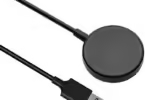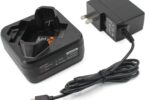You must be familiar with taking selfies and turning the back camera to the front camera. Front-facing cameras are not only used for selfies but also for a plethora of reasons like video calls and as a part of facial recognition. The transition from Notches to Under-Display Cameras has been a trend now.
Well, until recently, it was required for makers of front-facing cameras in smartphones to design a notch, hole, or other cut-out to create an unobstructed view. Now both the users and designers want to make the most of the amount of screen space. The screen-to-body ratio has been shrinking for a decade now.
ELIMINATING CAMERA CUTOUT
Regrettably, eradicating the camera cut-out on such devices is not feasible in the present. These notches or holes, as it is popularly referred to are locations where the front-facing camera and other important sensors reside. However, if you want them to be less prominent or even completely invisible, you can try to do so based on your phone model choice and personal preferences.
If you have a Samsung phone with One UI software, there is a section you can look through called “Full-screen apps”. This makes it possible to select applications where the front-facing camera capture region is blackened with a bar at the top. This does away with the notch, from a design perspective, but makes a small portion of the screen unavailable.
In particular, some phone developers are trying to go from Notches to under-display camera settings. This places the camera beneath the very screen and thus provides a significantly more immersive experience with no restrictions. All the same, this technology is still in its infancy and the chances of finding this type of device in current markets are still limited are still very rare at the moment.
As of now, most programs that solve the problem do not remove itself physically but work it out where most of the changes made are software changes. Though these solutions do not eliminate the camera cut-out, they are quite useful in reducing the chances of it being observed by the viewers.
UNDER-DISPLAY TECHNOLOGY
With a desire to have a screen that offers zero-notch interference, under-display camera technology has emerged. This new concept covers the area where the front-facing camera is placed within the display leaving the device screen without any notch.
Okay, and how does it function? Typically, telephone screens are based on the backlighting system; under-display cameras call for a segment with elevated light transmission. This is accomplished via some material science wizardry, a defining characteristic of lattice structures. Innovative, tiny opening holes, or transparent apertures, are introduced within the layers of the display to let light enter the integrated camera sensor without obstructing the screen underneath.
However, one must understand that the Notches to Under-Display Cameras technology is still at the nascent stage. If a company decides to do away with the notch-notch-less displays normally comes at the expense of a little screen quality. These may prevent light from reaching the camera sensor or block some of the light resulting in a less clear photo. Also, some of the users complain of a faint Avalon grey surround of the camera area in particular lighting conditions.
Notches to Under-Display Cameras, the prognosis of such pitfalls cannot overshadow the numerous opportunities offered to people in gaining access to various information services. Think of a phone where videos and of course, the games take the whole screen and nothing is spreading across the left-right-up-down part of the screen. Manufacturers are continuously working to enhance the technology, and more density of pixels and control on lights shall lead to much better picture quality in the coming years.
UNDER-SCREEN CAMERAS
This desire has sparked the development of the Under-Display Camera (UDC) technique and its applications as a promising mobile innovation for users. It also pioneered the under-display camera system where the front-facing camera is located under the main display, thus eliminating the front bezel. Notches to Under-Display Cameras, it is still a young field, and it may be useful to ask how it functions, along with the benefits and difficulties implicating this emerging technology.
The Magic Behind the Display:
In general, Notches to Under-Display Cameras the illustration of phones utilizes the backlighting effect, but for UDCs, a separate area with higher light transmittance is needed. This is enhanced through meticulously crafted engineering. It is suggested that tiny translucent apertures arranged in a pixel array are opened to provide the passage for light to the camera sensor but are shrouded with other pixels. Let’s just think of really small highlighted squares placed right on the fabric of the screen and we cannot see them.
Challenges and Trade-offs:
Although the UDC technology provides a consequence, spectacular and unraveled view, it is still rather innovative. The primary challenge is the compromise between video and screen quality. The fully transparent region can also partially obscure the light getting to the camera sensor, which could reduce photo quality. Nevertheless, some users have mentioned that in conditions of high illumination, there is a possibility to notice an odd glow around the camera area.
Innovation for a Brighter Future:
Nevertheless, the concept of UDCs has this benefit: To sum up, the main advantages of UDCs are evident and allow for several important considerations. And you wished that your phone would be a little more focused – on videos and games, completely without any other smooth surfaces to distract. Manufacturers are actively improving the technology, focusing on:
- Pixel Density: More to the point, by densifying the camera area pixels to cover more pixels on the screen, manufacturers are in a position to create a finer net to filter or let in more light to the screen while at the same time retaining a relatively good picture quality on the screen.
- Light Manipulation Techniques: Graphics-specific formulations and techniques used in writing display algorithms can also reduce interferences of light thus enabling the display to have correct perceived color and luminance intensity.
- Advanced Camera Sensors: As for the former, enhanced camera sensor design particularly for under-screen usage is vital because images taken in low light conditions are overall of superior quality.
- Software Optimization: Under-screen cameras can offer an even higher quality picture than traditional camera sensors if supported by efficient image processing that adapts to the low-light environment and improves photo detail, noise level, and overall image clearness.
- Display Calibration: Careful tuning of the display panel addresses issues of the dispersion of light within the camera aperture across the screen area thus eliminating the formation of different color casts in the end product.
The Road Ahead:
Under-screen camera technology is not set in stone yet, yet the progress displayed can indicate the route to the future in which the front-facing cameras are almost invisible on clean-faced screens. This technology implies the total mobile experience without loss of photographic excellence. Embedded in this maturation process is the hope that smartphone design will make even deeper advancements to be smoother and have better image quality in the future.
Some companies that provide under-display camera are:
Buy Now Buy NowENSURING QUALITY OF DISPLAYS WITH UNDER-SCREEN CAMERAS
Concerning the issue of light transmittance through the display, it is possible to overcome the problem of achieving a high-quality UDC image quality. Here’s how manufacturers are ensuring quality on both fronts:
Display Quality:
- Pixel Density: The idea is that by creating a denser grid of pixels in the camera area, it is possible to achieve a smaller aperture which will let in more light although deteriorating the image quality on the screen not significantly.
- Light Manipulation Techniques: Here, end-user separation algorithms and display materials are useful to reduce light interference from the camera area. This standardizes the amount of color variation and brightness that will be emitted by the display.
Camera Performance:
- Sensor Design: Better camera sensor technology is imperative, and when used specifically for under-display settings, significant enhancement must be made. These can have the ability to produce quality pictures even if much lighting is being received at the given sensors.
- Software Optimization: One of the applications of the image-processing method is to improve images photographed using concealed camera screens. These algorithms are effective for compensating for insufficiency of light and enhancement of the detail, noise, and quality of the image.
- Display Calibration: Due to flexibility in the material, a fine-tuning of the display panel to the camera area may be required since the transparency of the display panel may vary across the display. This conceals light augment and eliminates color casts from the images to be captured.
While under-display camera technology is still evolving, these advancements are paving the way for a future where pristine displays seamlessly integrate front-facing cameras, offering the best of both worlds: an illusion of continuous image without breaking the flow to look at the screen while maintaining picture quality.







